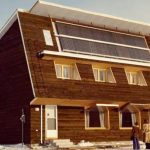
Nogs (North Island slang) or Dwangs (South Island slang) are an interesting cultural relic. Eliminated long (50 years) ago from the rest of the western world when kiln dried timber became commonplace, NZ engineers still hang onto these non-structural elements because “that’s what’s commonly done here”. Their (dwangs, not engineers, but actually maybe engineers too) only function these days is to draw more heat out of the building , cut down more crappy Radiata Pine trees (can we plant something else that doesn’t rot if you sneeze on it?), and to maintain the “she’ll be right, we’ve always done it this way” nostalgia. Dwangs are costing us money, wasting time, and holding back things that are actually useful.
Timber frame designers and engineers have long since lost the plot, ignoring study (BRANZ 1998), after study (Chapman 2011), after study (BRANZ 1991), after study ( BRANZ 2011), (Collins 1974, sorry I couldn’t find this one online if you have it please send it shawn@oculusltd.co.nz) calling the practice of nogging as unnecessary. Even the very precious timber code they are referencing doesn’t require dwangs (more on that below). Plain and simple here:
Dwangs are not required in timber walls
Better windows cost a bit more but if you spent some more money on good windows, you might actually get a building enclosure that meets the building code requirements (E3 and H1), and you’d get some value in return. Warmer windows, less condensation, less heat loss, happier occupants, less mould, higher resale value! Yay! Triple high fives all around! Value for money. Well you don’t “have to” buy good windows (actually you might and probably should) but you 100% don’t “have to” use dwangs and the later should make you even more upset.
When you add a dwang into a wall, you create a thermal bridge that lets more heat escape. You get no significant improvement to the structural performance of the wall. The acoustics are worse. You can’t sell the home for more (tough sales pitch: “This beauty has little bits of extra timber that you can’t see and they even make the home a bit colder”,”Is it structurally better”,”No, not at all”). You made 31% more timber cuts, and bought 50% more nails and the benefit you got from it? a worse performing envelope. That’s the opposite of a good idea, pay more for a worse product.
“How much could you save, Shawn, it’s just some bits of timber? How about $28/sqm of floor area; one study found that (on a timber frame house). That might be high for an apartment and I don’t claim to know the dark art of quantity surveying but the cost of dwangs isn’t zero. Quick maths: let’s build an apartment building with 30 units each being 65 sqm and let’s spend an extra $28/sqm because “tHaT’S ThE waY wE’Ve aLwaYS doNE iT.” You just spent $54,600 to make your building worse.
The worst part of all of this is no where does it say dwangs are mandatory or that’s the way it’s done here. Point to where it says that and then slide your hand up the page 35mm where it says exactly the opposite and that’s been reiterated in the studies and bulletins above. Here is the clause from NZS 3604 – 8.5.4 Lateral support of studs:
All studs shall be laterally supported by either:
(a) Exterior wall claddings complying with E2/AS1 or interior linings complying with section 12. Such material shall be fixed to the studs by direct nailing of cladding or lining material, provided that building paper or similar material not exceeding 3 mm thick may separate the lining or cladding material from the stud; or
(b) Dwangs, walings, or metal angle walings in accordance with 8.8.
Let’s use option a) because presumably your building has cladding (RAB counts by the way). A class I took long ago (maybe 3rd grade) taught me that the word or means choose one not both, so if we have done option a) we don’t need option b) ipso facto, (tranlation: Bob’s your uncle) = no dwangs required. Case closed.
Alright, before you go spending that $54,600 on new ute, instead of an electric vehicle (64 Utes : 1 Electric vehicle) maybe we look at the cost of some better window frames so our perspective occupants aren’t coughing and freezing in their new “code minimum” building. Again I’m no QS, but 30 apartments of which the material cost of the windows are ~$300,000, 10% more for thermally broken, so that $30k spent on adding value. Or maybe even spend $500 bucks for something so ostentatious as a mechanical ventilation system. You’ve still got $9,600 left over for that downpayment on the Ford Ranger. So I’m no real estate agent, but could I get $1,600 per apartment more for an energy efficient sustainable well insulated ventilated apartment? The records say unequivocally yes (Energy efficient homes – do they sell for more?).
In summation, here’s my plan, let’s call it “Dwangless Construction”:
- delete the dwangs,
- buy better windows,
- buy a ventilation system,
- keep occupants warmer and drier,
- cost neutral
Tell me I’m wrong.





The reason there is so many “nogs” used in nz is because you frame at 600mm Centers here, the walls are not ridged enough they stand and plumb a wall with out them. Most other countries frame at 400 for internal walls and one line of “nogs” in the center of the stud to stop twisting and pull the wall straight ie. small bows in timber. On external walls they are framed in 6×2 with 1/2 inch plywood on the external side of the wall and no “nogs”. The walls need something to keep them ridged otherwise they will twist and belly out. Having no nogs on a wall that is framed at 600 centres out of 4×2 is crazy.
I’m a carpenter from Ireland living in nz since October and I’m really shocked at the way house’s are built here and the lack of wanting to try change, your company is a breath of fresh air.
Cheers,
Shane